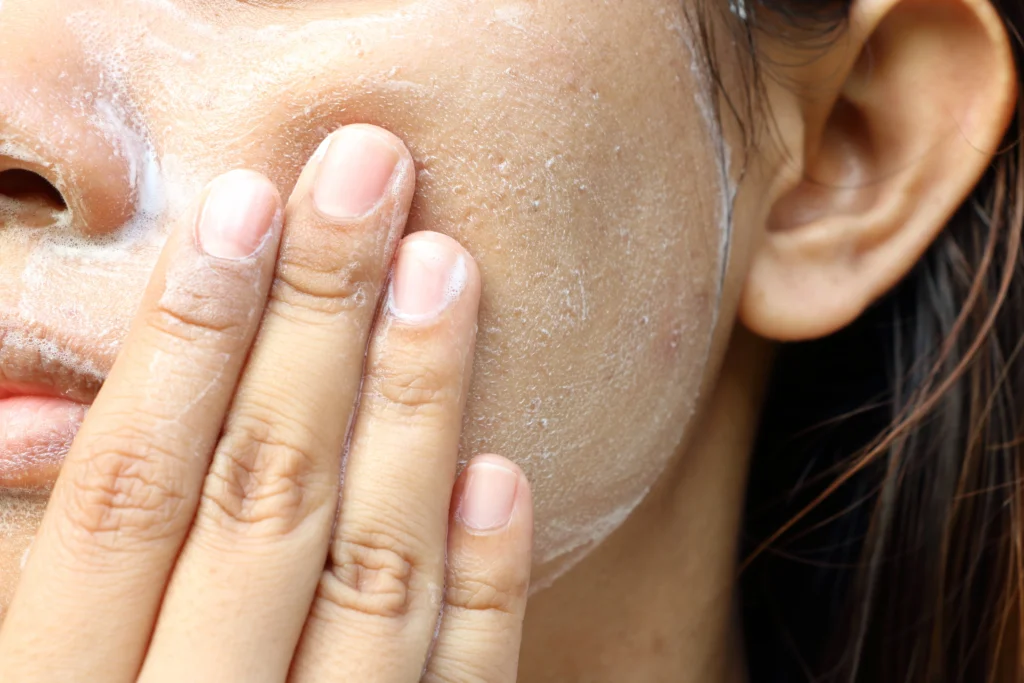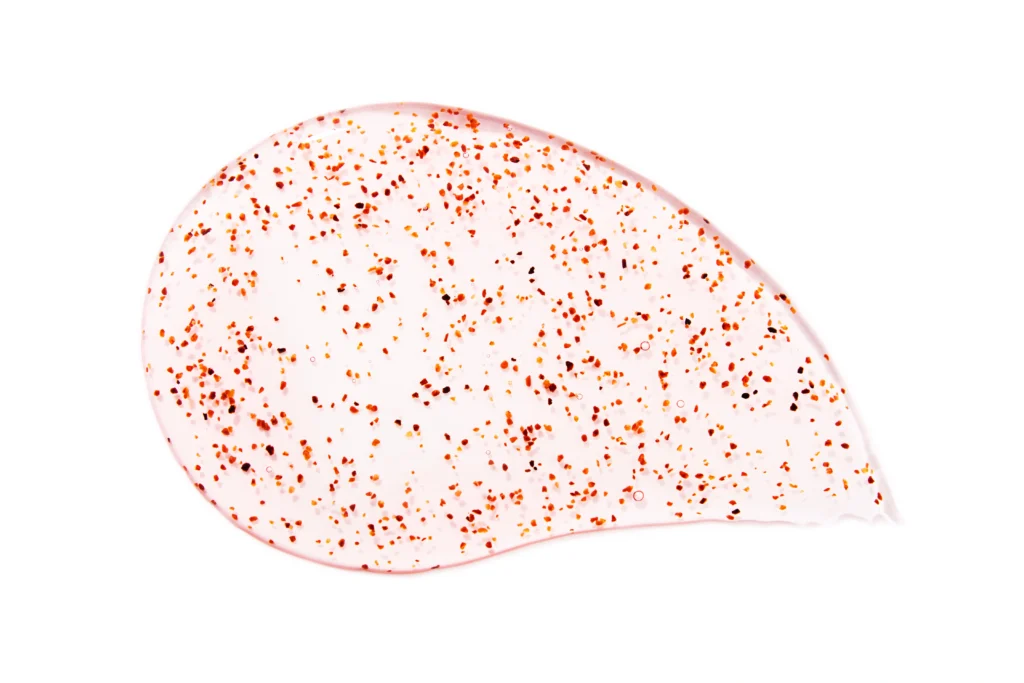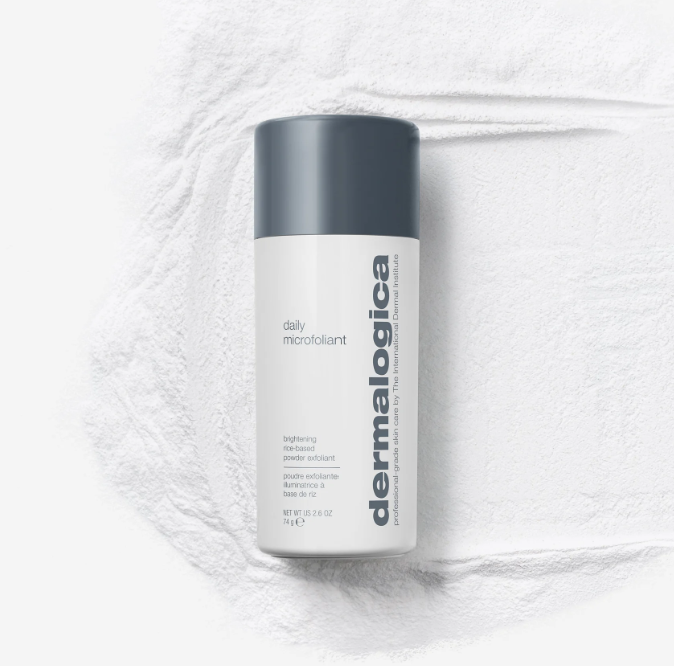
Have you ever noticed your skin feeling unusually tight, looking red, or breaking out more than usual? You might be falling victim to one of the most common skincare mistakes: over-exfoliation. While exfoliation can be a great way to achieve that coveted glow, too much of a good thing can wreak havoc on your skin’s delicate balance.
There’s a fine line between effective exfoliation and overdoing it.
Key Takeaways
- Over-exfoliation occurs when too many layers of skin are stripped away, disrupting the skin’s protective barrier.
- There are two main types of exfoliants: physical and chemical.
- Signs of over-exfoliation include redness, increased sensitivity and dryness.
- Different skin types should use appropriate exfoliants: salicylic acid for oily skin, lactic acid for dry skin, PHAs or enzymes for sensitive skin.
- To recover from over-exfoliation, stop exfoliating, simplify your skincare routine and use soothing ingredients.
- To prevent over-exfoliation, listen to your skin, choose the right method, limit frequency, use gentle pressure, and always moisturise afterward.
Table of Contents
What is Over-Exfoliation?
When done correctly, exfoliation helps remove dead skin cells, unclog pores, and promote cell turnover. However, over-exfoliation occurs when we strip away too many layers of skin, disrupting the skin’s protective barrier.
This can happen from using harsh products, exfoliating too frequently, or combining multiple exfoliating methods without giving your skin time to recover.
If you’ve been enthusiastically scrubbing away or applying chemical exfoliants too frequently, you might be sabotaging your skin’s natural barrier.
The type of exfoliant matters, too, as different exfoliants are better suited for different skin types and concerns.
Types of Exfoliants
Before we get to the signs of over-exfoliation, let’s take a look at the two main categories of exfoliants: physical and chemical.
Physical exfoliants use small particles or tools to manually scrub away dead skin cells. They are:
- Scrubs with beads or grains
- Brushes or sponges
- Microdermabrasion devices
Chemical exfoliants use acids or enzymes to dissolve the bonds between dead skin cells. Common types include:
- Alpha hydroxy acids (AHAs) like glycolic acid
- Beta hydroxy acids (BHAs) such as salicylic acid
- Fruit enzymes from papaya or pineapple
Chemical exfoliants are often gentler and more effective than physical methods for many skin types.
Now that we understand the different types of exfoliants, it’s crucial to recognise when we might be overdoing it. Over-exfoliation can sneak up on you, gradually wreaking havoc on your skin’s delicate balance.
Whether you’re using physical scrubs or chemical acids, you must pay close attention to your skin’s response.

9 Warning Signs of Over-Exfoliation
So, how do you know if you’ve crossed the line from healthy exfoliation to damaging your skin’s barrier? Here are 9 warning signs that indicate you might be over-exfoliating:
1. Redness and Irritation
One of the most immediate and visible signs of over-exfoliation is persistent redness and irritation. When you’ve gone overboard with exfoliation, your skin may appear inflamed and feel hot to the touch. This reaction occurs because excessive exfoliation removes not just dead skin cells but also damages healthy ones, triggering an inflammatory response.
2. Increased Sensitivity
If you find your skin suddenly reacting to products it once tolerated well, over-exfoliation might be the culprit. Over-exfoliated skin becomes hypersensitive, making it more reactive to touch, temperature changes, and skincare products. You might experience stinging or burning sensations when applying even gentle moisturisers or serums.
3. Shiny, Tight Skin
Contrary to popular belief, extremely shiny skin isn’t always a sign of health. If your face looks unusually glossy but feels tight and uncomfortable, you’ve likely over-exfoliated. This shininess is due to the skin’s compromised barrier function and excessive removal of natural oils, leaving your skin’s surface unnaturally smooth and reflective.
4. Dryness and Flakiness
Paradoxically, over-exfoliation can lead to both oiliness and dryness. As you strip away too many layers of skin, you compromise its ability to retain moisture. This can result in dry, flaky patches, especially around the nose, mouth, and cheeks. Your skin might feel rough to the touch, despite looking shiny in some areas.
5. Increased Oil Production
In response to the loss of natural oils from over-exfoliation, your skin may go into overdrive, producing excess sebum to compensate. This can lead to an oily, greasy appearance, particularly in the T-zone. If you find yourself blotting more frequently or notice your makeup sliding off faster than usual, excessive exfoliation might be to blame.
6. Breakouts and Acne
While exfoliation is often touted as a solution for acne, overdoing it can actually exacerbate the problem. Over-exfoliated skin is more susceptible to bacteria, leading to increased breakouts. You might notice small, rough, bumpy pimples or whiteheads appearing more frequently, especially in areas where you don’t typically experience acne.
7. Uneven Skin Texture
Over-exfoliation can lead to an uneven, rough skin texture. You might notice areas that feel waxy or develop an “orange peel” texture. This occurs because excessive exfoliation disrupts the natural skin renewal process, leading to irregular cell turnover and an uneven surface.
8. Visible Fine Lines or Cracks
Premature ageing signs can appear when you’ve over-exfoliated. The skin may develop tiny, visible cracks or fine lines, especially around the eyes and mouth. These lines are often temporary but indicate that your skin’s barrier function is compromised, leaving it vulnerable to environmental stressors and accelerated ageing. Additionally, over-exfoliated skin can appear dry and dull, which may make fine lines more noticeable.
9. Persistent Redness or Blotchiness
If you notice persistent red patches or an overall blotchy appearance that doesn’t seem to fade, it’s a clear sign you’ve overdone the exfoliation. This uneven tone results from irritation and inflammation in the skin, which can take time to calm down once you’ve disrupted the skin barrier.
If you’ve been experiencing any of these symptoms, it’s time to take a step back and re-evaluate your exfoliation routine. The key to avoiding over-exfoliation is to choose the right type of exfoliant for your skin type and to use it at an appropriate frequency.
How to Exfoliate Based on Skin Type
• Oily skin: Use salicylic acid (BHA) to unclog pores and control excess oil.
• Dry skin: Opt for gentle lactic acid or low-concentration glycolic acid to hydrate and remove dead skin cells.
• Sensitive skin: Choose mild exfoliants like polyhydroxy acids (PHAs) or enzymes.
• Combination skin: Use different exfoliants on different areas of your face as needed.
For uneven skin tone, consider using AHAs like glycolic acid to promote cell turnover and improve texture. If you’re using retinol in your skincare routine, be cautious with exfoliation to avoid over-sensitising your skin.
An exfoliant that is good for any skin type and absolutely loved by many is Dermalogica’s Daily Microfoliant Exfoliator.

Why It’s Good:
- Is gentle enough for daily use while still providing effective results.
- It works well for various skin types, including sensitive, acne-prone, oily, and normal skin.
- It helps to smooth and brighten the skin daily, yet is gentle enough to prevent damage from over-exfoliation.
- Is available in a refill pouch that reduces plastic usage by 92%, making it an eco-friendly choice.
How to Recover From Over-Exfoliation
If you’ve already over-exfoliated your skin, don’t worry – there are steps you can take to help your skin recover:
- Stop all forms of exfoliation immediately. Give your skin a chance to heal by avoiding any exfoliating products or tools.
- Simplify your skincare routine. Stick to gentle, fragrance-free cleansers and rich, nourishing moisturisers to help repair your skin barrier.
- Incorporate soothing ingredients like aloe vera, ceramides, and hyaluronic acid to calm inflammation and replenish moisture.
- Consider using a barrier repair cream to help restore your skin’s protective layer.
- Be patient. It can take several weeks for over-exfoliated skin to fully recover.
Once your skin has healed, gradually reintroduce exfoliation into your routine, starting with once a week and slowly increasing frequency based on your skin’s tolerance.
How to Prevent Over-Exfoliation
While it’s important to take immediate action to help your skin recover from over-exfoliation, it’s equally important to develop a sustainable exfoliation routine that prevents future damage:
- Listen to your skin. If it feels sensitive or irritated, skip exfoliation.
- Choose the right exfoliation method for your skin type. Chemical exfoliants are often gentler than physical scrubs.
- Limit exfoliation to 1-3 times per week, depending on your skin’s needs and tolerance.
- Use gentle pressure when applying exfoliants or tools.
- Always follow exfoliation with moisturiser to replenish and protect the skin.
Remember, the goal of exfoliation is to gently encourage cell turnover, not to strip your skin of its protective layers.
Before You Leave
If this article has sparked your interest in exfoliation, be sure to check out our guide on exfoliation: “Types of Exfoliation: A Comprehensive Guide.“
And if you want to learn more about natural moisturising factors we’ve got an excellent article about that as well: “What are the 4 Pillars of an Effective Moisturiser?“